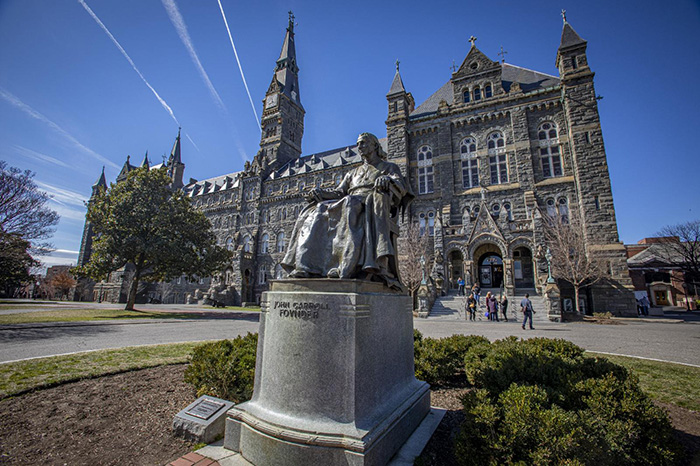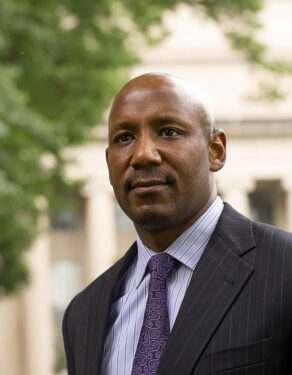
PROSPECT HEIGHTS — Historians point out that Catholics in colonial America actually owned slaves — most notably Jesuit priests in Maryland, who relied on tobacco plantation proceeds to fund their ministries.
This money also financed higher education, such as the creation of Georgetown University in 1789. In 1838, Jesuits sold 272 slaves to shore up Georgetown, which for its first 50 years did not charge tuition.
Leftover money from the 1838 sale paid for Catholic expansionism in states to the west and north, said Dr. Craig Steven Wilder, a history professor at the Massachusetts Institute of Technology.
Now, more than 200 years later, Jesuits are facing this legacy. Last year they pledged to raise $100 million to build educational opportunities and scholarships for descendants of the slaves.
Likewise, Wilder said, some Catholic colleges and universities “are rewriting their histories to address their past with slavery.”
Wilder, who grew up Catholic in Brooklyn, is the author of the 2013 “Ebony and Ivy: Race, Slavery, and the Troubled History of America’s Universities.” He is considered one of the nation’s most active researchers on the connections between slavery and higher education in the U.S.
“It’s both a story of the history of slavery, and the story of how slavery protected the Church, or at least gave it some way of sustaining itself during anti-Catholic crusades in the Protestant colonies and then in the early United States,” Wilder said.
Today, the Roman Catholic Church is considered the largest denomination in the U.S. — about 22% of the population. But from the mid-1500s through the late 1700s, England tried to stifle the Church throughout the world.

This hostility was entrenched for about 250 years, from King Henry VIII’s cutting ties with the Vatican in 1534 until the end of the American Revolution in 1784. During colonialism, only one colony tolerated Catholicism — Maryland.
These were tiny parishes, however, that generated very little revenue from tithes, Wilder said. So, he added, the priests purchased profit-generating tobacco plantations.
“That’s where the money came from,” added Richard Cellini, a lawyer, Harvard history professor, and Georgetown alum. “You have to understand that the business model of the Roman Catholic Church in British North America for 200 years was slavery.”
“I would say every institution in the country before 1900 has legacy ties to slavery,” Cellini said. “It’s not like money was manufactured or just materialized out of thin air. Everything was built on slavery. Everybody did it.
“So the Jesuits showed up in Maryland in 1634 and started these five slave plantations totaling 12,000 acres. The best estimate is that about 1,100 men, women, and children over that time worked on these plantations.”
Other colleges and universities founded by Jesuits have checked their own histories for any connections to slavery.
For example, Bob Howe, spokesman for Fordham University, said officials on the Bronx campus determined in 2017 that no direct connection to slavery existed.
Howe explained that the probe began when student journalists at the university saw reports of what was happening at Georgetown and wanted to know if Fordham had a similar history.
He said a small team of researchers spent a few months examining archives and also interviewed Jesuit historians. Howe explained that the priests who taught and administered at what became Fordham were from Kentucky, not Maryland.
“They were an international group, with most coming from France, England and Ireland,” Howe stated in an email. “As time went on, the Jesuits of the French Canada Mission (which became the New York-Canada Mission) were sent to Maryland for studies — at Georgetown, Woodstock (founded in 1869) and the novitiate in Fredrick, Maryland.
“The records in the Maryland Province archives indicate that the Maryland Province charged the New York-Canada Mission for tuition, books, habits, shoes, etc.
“The New York Jesuits did not derive any financial assistance from the Maryland schools.”
Meanwhile, Fordham presses on to promote racial justice.
“Advancing racial healing is baked into our mission: as an urban, Jesuit university we are keenly aware of the historical (and current) injustices suffered by black people in America,” Howe continued. “In the Spring semester, Arts & Sciences alone held 24 lectures on issues of racial justice.
“We have an extensive action plan — ‘Addressing Racism, Educating for Justice’— about which we update the university community quarterly, and our work on diversity, in general, is substantive and ongoing.”
Wilder earned his bachelor’s degree in history from Fordham in 1987.
He praised the university’s ongoing efforts to promote social justice. He has also returned to the campus as a guest lecturer to discuss slavery and higher education.
But Wilder and Cellini are certain that the influence of the early Maryland Jesuits is wide and deep, and that their efforts made it possible for Catholicism to spread west to places like Kentucky, and north into New York.
Thus, they urged all institutions — Catholic, Protestant, or public — to keep looking for connections to help advance reconciliation.
Cellini said this is a formidable commitment that could take decades and cost hundreds of thousands of dollars. He said the volumes of relevant records are vast, largely unchecked, but still open to the public.
Wilder said the costs justify the benefits of meaningful results.
“How does one maintain the Catholic or Jesuit commitment to social justice under the cloud of that past?” Wilder said. “That’s a difficult question. It’s a powerful question. But it’s exactly the right question.
“History shadows us, and we can’t run from it. Eventually, we have to turn and confront it, recognize it, and address it. And that is how some of the most meaningful conversations have evolved.”
